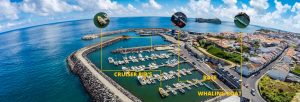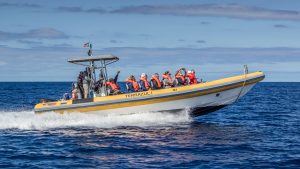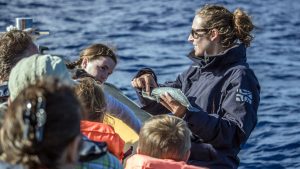If you book a whale and dolphin watching holiday to the main Azorean island of Sao Miguel with Archipelago Choice the chances are that your trips will start either from the marina in Ponta Delgada, the capital, or from Vila Franca (which was the capital until it was destroyed by an earthquake back in the early 1500s).

Morning or afternoon?
Trips last around 3 hours and you can choose to go out in the morning or the afternoon. A question we are frequently asked is what time is best, morning or afternoon? And my answer is that they can both be equally as good!
Whales and dolphins are in the ocean around the Azores all day long so, as long as the sea conditions are good and the boats can go out, you stand a good chance of seeing these animals whichever option you choose. And unlike some other destinations, it isn’t all just ‘guesswork’.

How to find the whales?
Back in the days of commercial whaling there were several spotting points (also known as vigias) dotted along the coast and from these locations powerful binoculars were used to scan the ocean and alert the boat crews when a whale was sighted.
These vigias are still in existence today and they are still used by skilled spotters to find the animals, only nowadays they alert the whale watching boats rather than the hunting parties. These guys are amazing, so skilled that they can tell a particular species from miles away just by seeing a blow, and this means the chances of seeing whales and dolphins are much greater than if you were to just jump in the boat, head out to sea and hope for the best.

So what should you expect?
A typical whale and dolphin watching trip starts off in the marina where all participants gather for a briefing before hitting the sea. The briefing covers some health and safety aspects but also includes lots of interesting information about what species of cetaceans are most frequently seen in the Azores, why they come to the Azores and what sightings have been like over the last few days. The vigias are constantly in touch with the rest of the crew so if they have seen anything (first thing in the morning or at lunchtime) that information will be passed on too.
After donning a life jacket (and waterproof if you so wish as it can be a bit splashy on board) you will board your whale watching boat and leave the shelter of the marina for the open ocean. Most trips use RIBs, rigid-hulled inflatable boats – a bit like the ones used as rescue boats – which seat around 12 passengers. There is also a catamaran option for those preferring to go out in a larger boat.
Marine Biologist
As well as your fellow whale watchers and the skipper you will be accompanied by a marine biologist who will keep you updated throughout the trip and tell you all about the species that you see.
Which whale species can you expect to see when?
Sperm whales are the resident species and most frequently sighted. They live in the waters around the islands all year round feeding on the giant squid that lurk deep down in the depths of the Atlantic.
The main ‘season’ runs from April all the way through the summer to October and during these months different species pass by the Azores on their migratory paths – April and May are usually a good time to go for a chance to see the larger whales such as blue, fin and sei whales, whilst October can be a good time to spot humpbacks. The most frequently sighted species of dolphin include bottlenose, Atlantic spotted and common dolphins.

Animal welfare
Those worried about the welfare and wellbeing of these amazing sea creatures can rest assured that all of our whale watching partners in the Azores adhere to strict guidelines when it comes to being around the animals.
The boats are only allowed to approach cetaceans from behind, never from in front, and they cannot get any closer than 50 metres – if there are calves present the distance limit is 100 metres. Whales are quite inquisitive animals and sometimes they do take an interest in the boats and come a little closer, which is absolutely fine if it is the animal’s choice!
If the cetaceans seem to be agitated in any way then the boat must leave the area, and as a rule boats shouldn’t stay in the vicinity of the same whale for more than half an hour.
Award winning Azores holidays specialists
So there you go, that pretty much sums up what happens during a typical whale and dolphin watching trip in the Azores. It really is amazing getting up close and personal with these beautiful animals, and the boat ride itself is great fun too! If this has piqued your interest why not head over to our Azores website to find out more about the whale and dolphin watching holidays we offer…
At Archipelago Choice, we have a team of Activity Holidays Specialists who know all about family holidays in the Azores. They are ready to answer all your questions…
We are a member of AITO (the Association of Independent Tour Operators) which encourages the highest standards in all aspects of tour operating. All members must adhere to the AITO Quality Charter.
Get in touch with Sarah today to find out more about our family holidays on 01768 721020, request a brochure or make an enquiry online with us.

